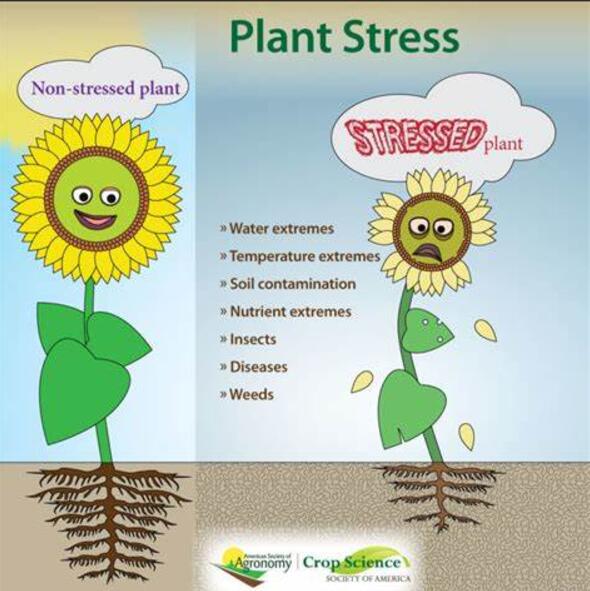Potato cultivars use distinct mechanisms for salt stress acclimation
IF 6.8
Q1 PLANT SCIENCES
引用次数: 0
Abstract
Soil salinity induces osmotic stress and ion toxicity in plants, detrimentally affecting their growth. Potato (Solanum tuberosum) suffers yield reductions under salt stress. To understand salt-stress resilience mechanisms in potatoes, we studied three cultivars with contrasting salt sensitivity: Innovator, Desirée, and Mozart. Innovator emerged as the most resilient under salt stress, displaying minimal reductions in growth and plant tolerance index with no tuber yield loss, despite notable water loss. Conversely, Desirée experienced a significant tuber yield reduction but maintained better water retention. Mozart showed a low plant tolerance index and high water loss. Interestingly, ions measurement across different tissues revealed that, unlike chloride, sodium does not accumulate in tubers under salt stress in these cultivars, suggesting existence of an active sodium exclusion mechanism. A whole root transcriptomic analysis of these cultivars revealed a conserved salt stress response between potato and Arabidopsis. This response includes activation of various abiotic stress pathways and involves sequential activation of various transcription factor families. Root analyses showed that Innovator has lower suberin and lignin deposition, along with stronger K+ leakage in control conditions, resulting in a higher early stress response and increased ABA accumulation shortly after salt stress induction. This could explain Innovator has a more divergent transcriptomic response to salt stress compared to Desirée and Mozart. Nevertheless, Innovator displayed high suberin and lignin levels and ceased K+ leakage after salt stress, suggesting a high acclimation ability. Altogether, our results indicate that acclimation ability, rather than initial root protection against salt prevails in long-term salt-stress resilience of potato.

土壤盐分会诱发植物的渗透胁迫和离子毒性,对其生长造成不利影响。马铃薯(Solanum tuberosum)在盐胁迫下会减产。为了了解马铃薯的盐胁迫恢复机制,我们研究了三个盐敏感性截然不同的栽培品种:创新者、德西雷和莫扎特。创新者在盐胁迫下表现出最强的抗逆性,尽管水分损失显著,但其生长和植物耐受指数的降低幅度很小,块茎产量也没有减少。相反,Desirée 的块茎产量显著下降,但保水性能较好。莫扎特的植物耐受指数较低,失水较多。有趣的是,不同组织的离子测量结果显示,与氯离子不同,这些栽培品种的块茎在盐胁迫下不会积累钠离子,这表明存在一种活跃的排钠机制。对这些栽培品种的全根转录组分析表明,马铃薯和拟南芥的盐胁迫反应是一致的。这种反应包括激活各种非生物胁迫途径,并涉及各种转录因子家族的顺序激活。根系分析表明,在对照条件下,创新者的单宁和木质素沉积较低,K+渗漏较强,导致早期胁迫反应较强,在盐胁迫诱导后不久ABA积累增加。这可以解释为什么与德西雷和莫扎特相比,创新者对盐胁迫的转录组反应更加不同。不过,创新者在盐胁迫后显示出较高的单宁和木质素水平,并停止了 K+ 泄漏,这表明其具有较强的适应能力。总之,我们的研究结果表明,在马铃薯的长期盐胁迫适应能力中,占主导地位的是适应能力,而不是最初的根系抗盐保护能力。
本文章由计算机程序翻译,如有差异,请以英文原文为准。
求助全文
约1分钟内获得全文
求助全文
来源期刊

Plant Stress
PLANT SCIENCES-
CiteScore
5.20
自引率
8.00%
发文量
76
审稿时长
63 days
期刊介绍:
The journal Plant Stress deals with plant (or other photoautotrophs, such as algae, cyanobacteria and lichens) responses to abiotic and biotic stress factors that can result in limited growth and productivity. Such responses can be analyzed and described at a physiological, biochemical and molecular level. Experimental approaches/technologies aiming to improve growth and productivity with a potential for downstream validation under stress conditions will also be considered. Both fundamental and applied research manuscripts are welcome, provided that clear mechanistic hypotheses are made and descriptive approaches are avoided. In addition, high-quality review articles will also be considered, provided they follow a critical approach and stimulate thought for future research avenues.
Plant Stress welcomes high-quality manuscripts related (but not limited) to interactions between plants and:
Lack of water (drought) and excess (flooding),
Salinity stress,
Elevated temperature and/or low temperature (chilling and freezing),
Hypoxia and/or anoxia,
Mineral nutrient excess and/or deficiency,
Heavy metals and/or metalloids,
Plant priming (chemical, biological, physiological, nanomaterial, biostimulant) approaches for improved stress protection,
Viral, phytoplasma, bacterial and fungal plant-pathogen interactions.
The journal welcomes basic and applied research articles, as well as review articles and short communications. All submitted manuscripts will be subject to a thorough peer-reviewing process.
 求助内容:
求助内容: 应助结果提醒方式:
应助结果提醒方式:


